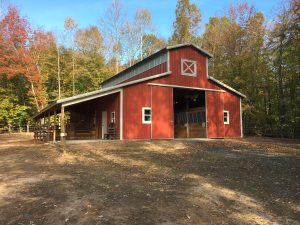If common sense was common, then articles like this one would not have to be written. One of the least expensive in upfront cost is also the most cost saving, when it comes to horse health and veterinary bills. Sadly, it is most often either an afterthought, or a “never even thought of” for horse barn ventilation.
Every horse stall should have some sort of sidewall openings which are permanent, they are left open year around. The best location for these openings is at the eave line – where the sidewall meets the roof. These openings should extend the entire length of the barn sidewall. This provides every stall with fresh air, as it is equally distributed along the length on both sides of the barn.
As the opening will be 10 to 12 feet above the floor (no, an eight foot eave height is not appropriate for a horse stall barn), the incoming cold air is mixed with warmer stable air before reaching the horses.
During cold weather, the full length ventilation provides a thin stream of cold, fresh air, as opposed to a large draft from an open door or window. In cold climates, the minimum guideline is to provide at least one inch of continuous-slot permanent opening for each 10 feet of building width.
 Enclosed sidewall overhangs; using vented vinyl soffit panels provides an intake solution which is affordable, practical and attractive. The most popular vented soffit panel is what is known as a “triple 3 center vent”. These panels have perforated openings in 1/3 of each panel. Depending upon the manufacturer, the panels deliver from four to five square inches of net ventilating area, per square foot of panel. A two foot wide overhang, across a 12 foot width stall, would therefore gain 96 to 120 square inches of net ventilating area, using the center vented soffit. Going to fully vented soffit panels, would triple the amount of air intake.
Enclosed sidewall overhangs; using vented vinyl soffit panels provides an intake solution which is affordable, practical and attractive. The most popular vented soffit panel is what is known as a “triple 3 center vent”. These panels have perforated openings in 1/3 of each panel. Depending upon the manufacturer, the panels deliver from four to five square inches of net ventilating area, per square foot of panel. A two foot wide overhang, across a 12 foot width stall, would therefore gain 96 to 120 square inches of net ventilating area, using the center vented soffit. Going to fully vented soffit panels, would triple the amount of air intake.
Along with air intake from the eaves, a continuous vented ridge must be provided. The ridge ventilation should be at least equal to (in square inches) the intake area provided for at the eaves. Properly designed ridge vents, allow for the warm moist air to exhaust at the ridge, without allowing the weather or debris into the building. At least a square foot of ridge vent should be provided, per horse. This may cause the need for additional venting, such as functional vented cupolas, to have to be added.
In order to encourage proper horse barn ventilation airflow, it is best to avoid having ceilings, or loft storage areas above stalls.
During warm weather, large doors can be opened to allow for cross ventilation – provided doors are on opposite walls.
I’ve never been a fan of windows in horse stalls. They tend to provide all too promising targets for young miscreants. If horses are to be kept in stalls during warm weather, outside openings of at least five to 10 percent of the floor area should be provided into each stall. For a typical 12 foot square stall, this means as much as 14-1/2 square feet. If outside runs are provided for each stall, a 4’ x 7’ sliding door will easily allow convenient access and adequate ventilation (and be affordable). With no run outs, a 4’ x 3’6” bale door, for each stall, may be a solution.
Open grill work on stall fronts, also help to aid in good stall ventilation.
One clear rule to follow – when in doubt, over ventilate. The costs will easily be gained in reduced vet bills, with healthy horses…who require adequate horse barn ventilation.






